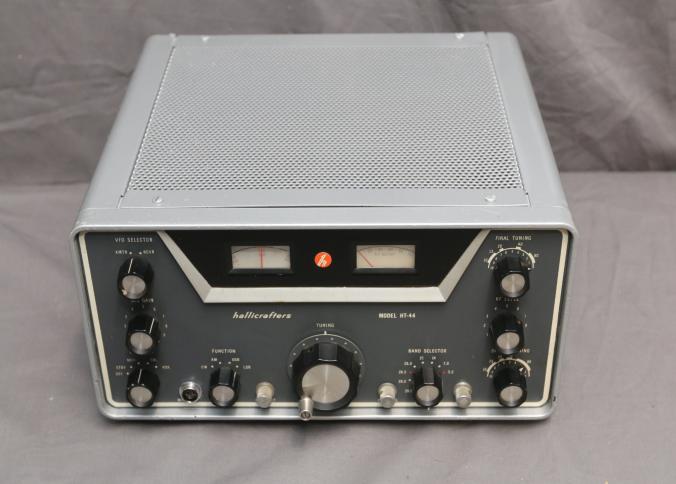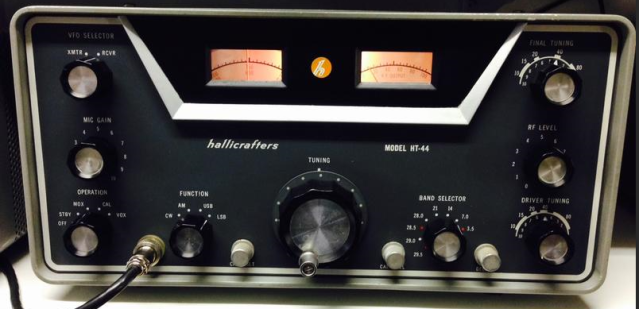
The Hallicrafters HT 44 is a legendary piece of equipment in the world of ham radio. This vintage transmitter, first introduced in the 1950s, has stood the test of time and remains highly sought after by amateur radio enthusiasts and collectors alike.
The HT 44 boasts a robust output power of 100 watts, making it suitable for both casual operators and serious DXers. Its high-quality components and meticulous craftsmanship ensure excellent signal quality and reliability. Whether you’re communicating with fellow hams across town or making long-distance contacts around the world, the HT 44 delivers exceptional audio clarity and signal strength.
One of the standout features of the HT 44 is its versatility. It covers a wide frequency range, allowing operators to access multiple amateur radio bands. The transmitter also offers various modulation options, including AM, CW, and SSB, giving users the flexibility to choose the mode that best suits their needs and preferences.
While the HT 44 may be a vintage piece of equipment, it is by no means obsolete. Many operators still use and cherish this classic transmitter, appreciating its timeless design and reliable performance. Whether you’re a seasoned ham radio operator or a collector of vintage electronics, the Hallicrafters HT 44 is a must-have addition to your collection.
The History of Hallicrafters HT 44
The Hallicrafters Company was founded in 1932 by William J. Halligan and was based in Chicago, Illinois. The company quickly gained a reputation for producing high-quality radio equipment, including receivers, transmitters, and transceivers.
The HT 44 was introduced in 1954 and was part of the company’s “HT” series of transmitters. It was designed to be a compact and affordable option for amateur radio operators who wanted a reliable and powerful transmitter.
Features

The HT 44 had several notable features that set it apart from other transmitters of its time. One of its key features was its power output, which could reach up to 75 watts. This made it suitable for long-distance communication and allowed operators to reach other radio enthusiasts around the world.
Another notable feature of the HT 44 was its frequency coverage. It was capable of transmitting on multiple bands, including the 80, 40, 20, 15, and 10-meter bands. This versatility made it a popular choice among amateur radio operators who wanted to explore different frequencies and modes of communication.
The HT 44 also featured a built-in VFO (Variable Frequency Oscillator), which allowed operators to easily tune the transmitter to their desired frequency. This made it more convenient to use and eliminated the need for external tuning equipment.
Specifications
Here are some of the key specifications of the Hallicrafters HT 44:
| Power Output | 75 watts |
|---|---|
| Frequency Coverage | 80, 40, 20, 15, and 10-meter bands |
| Modulation | AM, CW |
| VFO Range | |
| Tube Complement | 6CL6 (x2), 6L6 (x2), 6AU6, 6BA6, 6BE6, 6AL5, 6X4 |
Features and Specifications of Hallicrafters HT 44
The Hallicrafters HT 44 is a classic vintage ham radio transmitter that was produced by the Hallicrafters Company in the mid-20th century. It is known for its exceptional performance and durability, making it a popular choice among amateur radio operators.
Another notable feature of the HT 44 is its power output. With a maximum power output of 100 watts, this transmitter is capable of reaching long distances and communicating with other ham radio operators around the world. This makes it an ideal choice for DXing and contesting.
The HT 44 also offers a wide range of frequency coverage. It supports both the AM and CW modes, allowing operators to communicate using different modulation techniques. Additionally, it covers a frequency range of 3.5 to 30 MHz, providing access to various amateur radio bands.
In terms of controls, the HT 44 features a user-friendly interface. It has a large tuning dial, which allows for precise frequency selection. The transmitter also includes separate controls for adjusting the modulation level, RF gain, and antenna tuning, making it easy to optimize performance.
Furthermore, the HT 44 is equipped with a built-in VFO (Variable Frequency Oscillator), which enables continuous tuning across the entire frequency range. This eliminates the need for external crystals and simplifies the tuning process.
Collecting and Restoring Hallicrafters HT 44
Collecting and restoring vintage ham radio equipment is a popular hobby among radio enthusiasts. The Hallicrafters HT 44 is a classic vintage ham radio transmitter that is highly sought after by collectors. Restoring this iconic piece of equipment requires careful attention to detail and a passion for preserving the history of amateur radio.
Collecting the Hallicrafters HT 44

Restoring the Hallicrafters HT 44
Restoring a Hallicrafters HT 44 requires a combination of technical knowledge and patience. The first step is to carefully disassemble the transmitter, taking note of the original wiring and components. Any damaged or non-functioning parts should be replaced with authentic replacements to maintain the integrity of the unit.
After the restoration process is complete, the Hallicrafters HT 44 can be proudly displayed in a collection or used for on-air operation. Many collectors enjoy showcasing their restored vintage ham radio equipment at ham radio conventions and events.
Preserving the History
Collecting and restoring the Hallicrafters HT 44 is not just about owning a piece of vintage equipment. It’s also about preserving the history of amateur radio and honoring the craftsmanship of the past. By carefully documenting the restoration process and sharing knowledge with other enthusiasts, collectors can ensure that the legacy of the Hallicrafters HT 44 lives on for future generations.
| Pros | Cons |
|---|---|
| Highly sought after by collectors | Can be difficult to find in good condition |
| Preserves the history of amateur radio | Requires technical knowledge for restoration |
| Can be proudly displayed or used for on-air operation | May require replacement of original components |

Over the years, I have amassed a wealth of experience and knowledge, which I eagerly share with fellow radio aficionados. Through my writing and active participation in the amateur radio community, I strive to inspire others and provide valuable insights into this fascinating hobby. Engaging in various radio activities, I continue to learn and grow, constantly amazed by the endless possibilities that radio communication offers.

